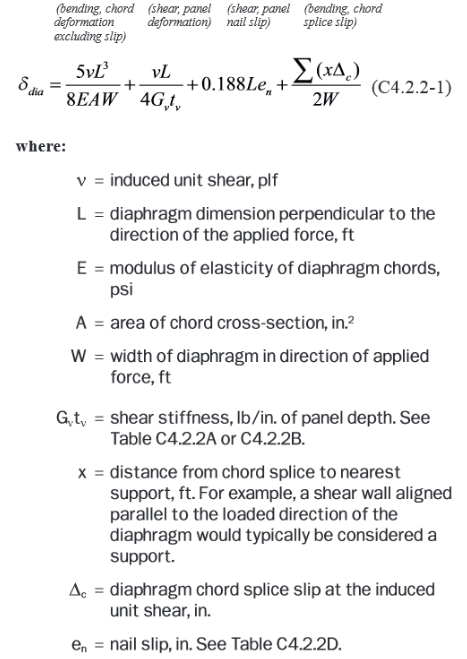According to NDS SDPWS Table 4.2A "Nominal Unit Shear Capacities for Wood Frame Diaphragms", 15/32" sheathing w/ 10d@6" edge nailing is stiffer than the same sheathing with tighter nail spacing (i.e., 10d@4"), and is also stiffer than thicker sheathing with the same nailing pattern (i.e., 19/32" sheathing w/ 10d@6"). This seems counterintuitive to me. Can anyone explain why?
Navigation
Install the app
How to install the app on iOS
Follow along with the video below to see how to install our site as a web app on your home screen.
Note: This feature may not be available in some browsers.
More options
Style variation
-
Congratulations MintJulep on being selected by the Eng-Tips community for having the most helpful posts in the forums last week. Way to Go!
You are using an out of date browser. It may not display this or other websites correctly.
You should upgrade or use an alternative browser.
You should upgrade or use an alternative browser.
Wood Diaphragm Stiffness, Ga
- Thread starter gte447f
- Start date
- Status
- Not open for further replies.
Ga is a simplification factor when converting the more accurate 4-term equations to the arguably easier to use 3-term equation. Check the commentary and appendices if you would like additional information on the 4-term equation, but I'll include it here:

Because Ga is a simplification that includes the nail slip term, when we increase the number of nails by tightening up the nail spacing, which then increases the allowable load in the diaphragm, we increase the nail slip. Hence, the non-intuitive Ga numbers in tables 4.2A-4.2C.
19/32" panels have higher allowable loads, and therefore, more nail slip and shear deformation, so the Ga takes a hit.

Because Ga is a simplification that includes the nail slip term, when we increase the number of nails by tightening up the nail spacing, which then increases the allowable load in the diaphragm, we increase the nail slip. Hence, the non-intuitive Ga numbers in tables 4.2A-4.2C.
19/32" panels have higher allowable loads, and therefore, more nail slip and shear deformation, so the Ga takes a hit.
DoubleStud
Structural
Maybe I am missing something, I see higher capacity as you space it closer.
- Thread starter
- #5
Doublestud, yes, the capacity increases with tighter nail spacing, but the stiffness term, Ga, decreases, at least for some combinations of sheathing thickness and nail spacing.
I think ChorasDen’s explanation makes sense. Basically more nails results in more nail slip.
Thanks for the responses, I don’t have time right now, but I will check back to continue the discussion.
I think ChorasDen’s explanation makes sense. Basically more nails results in more nail slip.
Thanks for the responses, I don’t have time right now, but I will check back to continue the discussion.
- Thread starter
- #6
Most design equations using an experimental regression are approximations, however, I would say that the 3-term equation is an even more loose approximation, because it takes experimental data, tries to fit a regression to it, and then adjusts the terms to make the analysis easier for the average engineer. If you are trying to increase stiffness by limiting capacity of a diaphragm with tight nail spacing, I don't know of a good way to do so offhand using the 3-term equation. However, if you artificially cap the diaphragm capacity below the nominally adjusted capacity in the relevant tables, I could see a way of increasing the stiffness of the system by reducing the nail slip value per nail and shear stiffness in the 4-term equation.
Long story short, if using the 4-term, I believe so, if using the 3-term and Ga, I don't know of a convenient way to increase stiffness.
Long story short, if using the 4-term, I believe so, if using the 3-term and Ga, I don't know of a convenient way to increase stiffness.
- Status
- Not open for further replies.
Similar threads
- Replies
- 15
- Views
- 10K
- Replies
- 6
- Views
- 3K
- Replies
- 6
- Views
- 917
- Replies
- 23
- Views
- 3K
- Replies
- 1
- Views
- 11K
